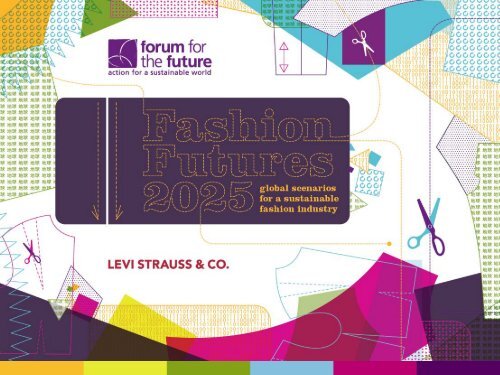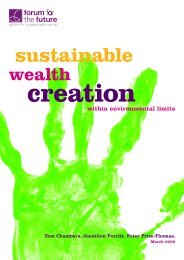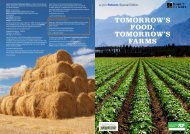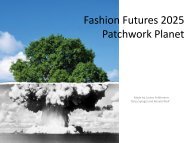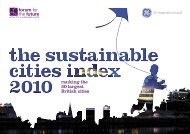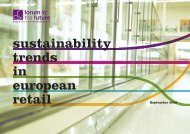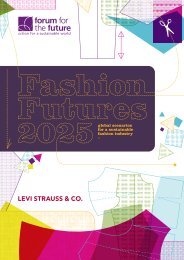Fashion Futures 2025 - Forum for the Future
Fashion Futures 2025 - Forum for the Future
Fashion Futures 2025 - Forum for the Future
Create successful ePaper yourself
Turn your PDF publications into a flip-book with our unique Google optimized e-Paper software.
why futures?<br />
• +++
why scenarios?<br />
To support:<br />
Communication of sustainability issues<br />
Strategy development<br />
Product, service and process innovation<br />
See our website <strong>for</strong> useful workshop materials:<br />
www.<strong>for</strong>um<strong>for</strong><strong>the</strong>future.org/projects/fashion-workshopmaterials
about fashion futures<br />
Joint project between Levi Strauss & Co and <strong>Forum</strong> <strong>for</strong><br />
<strong>the</strong> <strong>Future</strong><br />
In consultation with over 40 experts, we constructed four<br />
plausible, stretching scenarios <strong>for</strong> what <strong>the</strong> global fashion<br />
industry could look like in <strong>2025</strong><br />
Began in October 2008 and launched at London <strong>Fashion</strong><br />
Week in Feb 2010<br />
– an engaging online report and printed executive<br />
summary<br />
– four short animations that represent <strong>the</strong> scenarios<br />
– workshop materials: exercises, presentation, agenda
objectives of <strong>the</strong> project<br />
To communicate a well-researched, lively and engaging<br />
series of scenarios and recommendations<br />
To promote a more sustainable future <strong>for</strong> <strong>the</strong> global<br />
fashion industry<br />
To stimulate a debate about <strong>the</strong> future <strong>for</strong> global fashion<br />
and inspire a more sustainable response to it
fashion futures <strong>2025</strong><br />
global scenarios <strong>for</strong> a sustainable fashion industry
Some certainties we can expect…<br />
Impacts of climate<br />
change<br />
Resource costs<br />
& shortages<br />
Demographic change<br />
Severe and unpredictable wea<strong>the</strong>r<br />
Shifting rainfall patterns<br />
Global target: cut CO2 50% by 2050<br />
<strong>2025</strong>: 1.8 billion people living with<br />
water scarcity; food, building<br />
materials, energy, cotton: oil @ $130<br />
in 2030<br />
1.3 billion more people by mid-2020s<br />
Ageing population in developed world
…some factors we are less certain about<br />
• How will society respond to resource scarcity and climate<br />
change?<br />
• How might legislation shape <strong>the</strong> fashion industry?<br />
• How much disposable income will we have, and what will we<br />
spend it on?<br />
• How will <strong>the</strong> so-called ‘emerging economies’ develop?<br />
• Technological advancement<br />
• Consumer acceptance of sustainable consumption<br />
• How might demographic changes affect <strong>the</strong> clothing<br />
industry?
two areas of high importance and uncertainty<br />
1. How connected is <strong>the</strong> world?<br />
Connected where economic globalisation has expanded<br />
fur<strong>the</strong>r, trade barriers have lowered, communications are<br />
more united and global cultures are more similar.<br />
Fragmented where globalisation has gone into reverse, <strong>the</strong>re<br />
is more protectionism, long distance trade is declining and<br />
regional identities are stronger.
two areas of high importance and uncertainty<br />
2. How fast do society and its fashions change?<br />
Fast where speed of change has accelerated: in media and<br />
communications; in flows of financial capital; and in how<br />
people express <strong>the</strong>mselves through culture and fashion.<br />
Slow where <strong>the</strong> rate of consumption has reversed; flows of<br />
financial capital are slower; and cultures change more<br />
gradually.
Slow is<br />
Beautiful<br />
Political<br />
collaboration and global<br />
trade in a world where<br />
slow and sustainable is<br />
fashionable
Community<br />
Couture<br />
Resource<br />
crises constrain<br />
consumption in a<br />
local community<br />
focused world
High tech<br />
systems deliver<br />
<strong>for</strong> a speedobsessed<br />
global<br />
shopper<br />
Techno-<br />
Chic
Fast consumption<br />
in global cultural<br />
blocs<br />
Patchwork<br />
Planet
Slow is<br />
Beautiful<br />
Community<br />
Couture<br />
<strong>Fashion</strong> <strong><strong>Future</strong>s</strong> Scenario Axis<br />
Political<br />
collaboration and global<br />
trade in a world where<br />
slow and sustainable is<br />
fashionable<br />
Resource<br />
crises constrain<br />
consumption in a<br />
local community<br />
focused world<br />
High tech<br />
systems deliver<br />
<strong>for</strong> a speedobsessed<br />
global<br />
shopper<br />
Fast consumption<br />
in global cultural<br />
blocs<br />
Techno-<br />
Chic<br />
Patchwork<br />
Planet
Slow is<br />
Beautiful<br />
Community<br />
Couture<br />
Techno -<br />
Chic<br />
Patchwork<br />
Planet
–<br />
–<br />
–<br />
CAUTION!<br />
TREAT SCENARIOS WITH CARE<br />
Not predictions, but images of possible futures,<br />
tools to imagine what world could look like<br />
Stimulate new ideas -<br />
opportunities<br />
challenges and<br />
Test strategies <strong>for</strong> robustness
Slow is Beautiful<br />
Collaboration in a world where slow and sustainable is fashionable<br />
– This is a moralistic world of low-carbon, sustainable<br />
lifestyles<br />
– Strict carbon regulation and sophisticated tracking and<br />
labelling mean consumers are more aware of all impacts<br />
– The majority of consumers are willing to pay more <strong>for</strong> a<br />
smaller number of high-quality, sustainable clothing items.<br />
– <strong>Fashion</strong> styles are gradually becoming more homogenised<br />
and reflect a ‘safe’, less innovative world.<br />
– The fashion industry has worked hard to decarbonise, and<br />
shift people’s perceptions of <strong>the</strong> industry – post 20 th C<br />
consumption<br />
– Although ‘living wages’ are now <strong>the</strong> norm <strong>for</strong> factory<br />
workers, a ‘grey economy’ of cheaper fashion with poor<br />
working conditions still exists.
Techno -<br />
Chic<br />
High tech systems deliver <strong>for</strong> a speed-obsessed global shopper<br />
– This is a prosperous world which has benefitted from an<br />
early switch to a low-carbon economy and huge<br />
technological investment.<br />
– Smart consumers are flourishing in this high-tech, open<br />
world of few trade barriers and fast-paced fashion fads.<br />
– Man-made fabrics rule <strong>the</strong> fashion markets, providing<br />
personalised, high-tech, af<strong>for</strong>dable options across <strong>the</strong> globe.<br />
– Massive levels of automation and sharp declines in <strong>the</strong> use<br />
of labour create pockets of crippling unemployment<br />
across economies previously reliant on clothing manufacture<br />
and production.
Community Couture<br />
Resource crises constrain consumption in a local community<br />
focused world<br />
– Self-sufficient communities thrive in a world struggling to<br />
cope with <strong>the</strong> strain of growing populations and<br />
resource shortages.<br />
– Very high costs of raw materials and disrupted supply<br />
chains have resulted in a dramatic fall in <strong>the</strong> production and<br />
sale of new clothing.<br />
– In its place vibrant local networks of second-hand<br />
clothing have evolved: community bonds are strong and<br />
creative fashion solutions abound.<br />
– That said many consumers still strongly desire ‘new’<br />
clo<strong>the</strong>s – now af<strong>for</strong>dable only to <strong>the</strong> rich or on <strong>the</strong> black<br />
market.
Patchwork Planet<br />
Fast consumption in global cultural blocs<br />
– Years of conflict, exacerbated by uneven economic<br />
recovery from recession and a shortage of strategic<br />
resources.<br />
– Global community fragmented, with deep suspicion<br />
between cultural blocs.<br />
– A world of rapidly changing fashions – where styles are<br />
led by an economically and culturally powerful Asia.<br />
– Supply chains regionalise to meet consumer demand <strong>for</strong><br />
fast-changing, regional, patriotic fashion.<br />
– The world is struggling to cope with mounting social<br />
tensions and environmental constraints.<br />
– Many wonder how long this pace can last.
How to use <strong>the</strong> <strong>Fashion</strong> <strong><strong>Future</strong>s</strong> scenarios<br />
Use <strong>the</strong> scenarios to:<br />
future-proof your current business models and<br />
processes<br />
develop new strategies<br />
help <strong>for</strong>m your own vision of <strong>the</strong> future<br />
stimulate partnership working<br />
to innovate<br />
enable team and personal development
How to use <strong>the</strong> <strong>Fashion</strong> <strong><strong>Future</strong>s</strong> scenarios<br />
Use <strong>the</strong> scenarios to:<br />
<strong>Future</strong>-proof your current business models and<br />
processes<br />
Develop new strategies<br />
Help <strong>for</strong>m your own vision of <strong>the</strong> future<br />
Stimulate partnership working<br />
Innovate<br />
Enable team and personal development
For more in<strong>for</strong>mation<br />
visit<br />
www.<strong>for</strong>um<strong>for</strong><strong>the</strong>future.org/projects/fashion-futures<br />
contact us<br />
Vicky Murray | v.murray@<strong>for</strong>um<strong>for</strong><strong>the</strong>future.org<br />
Fiona Bennie | f.bennie@<strong>for</strong>um<strong>for</strong><strong>the</strong>future.org


